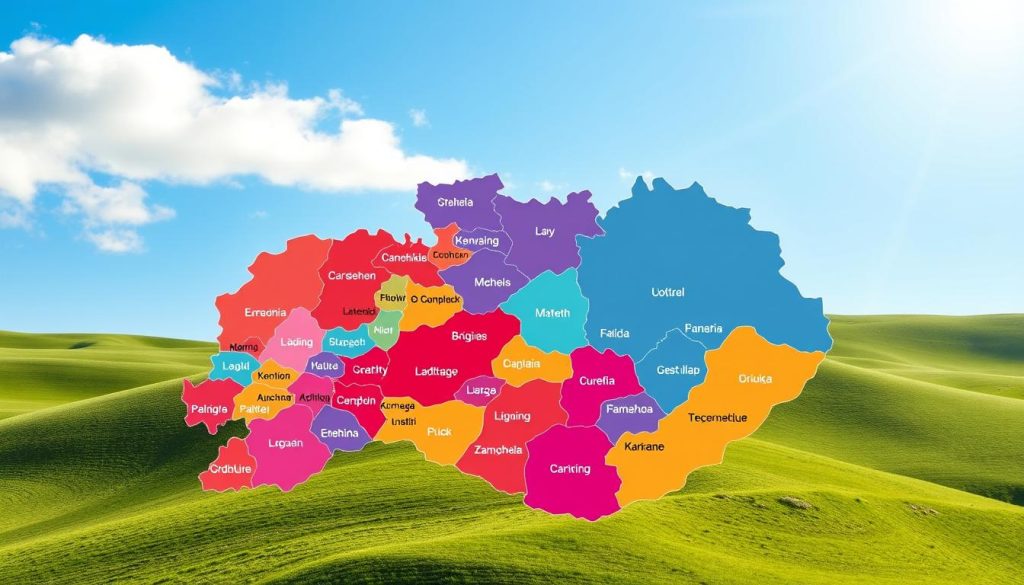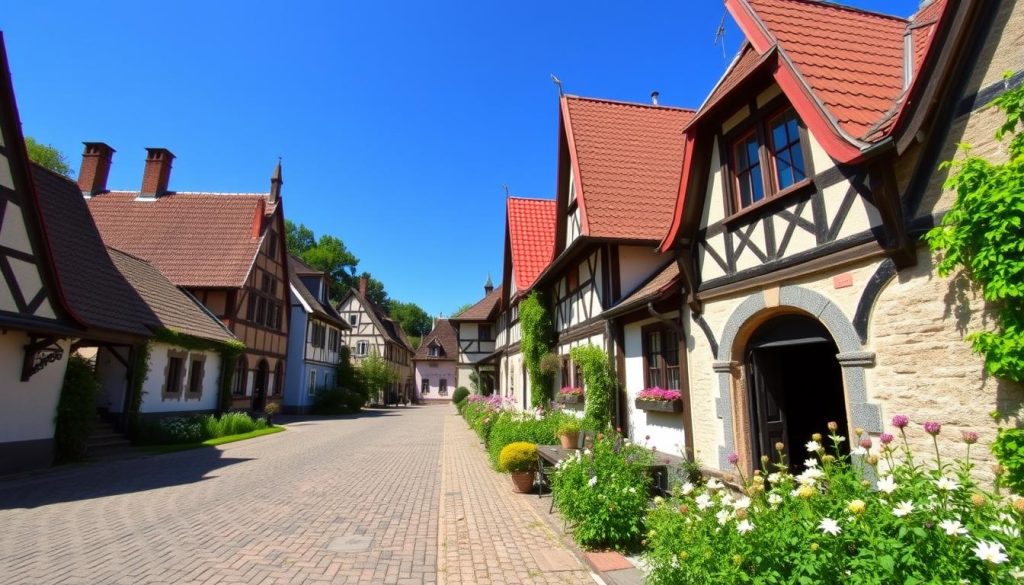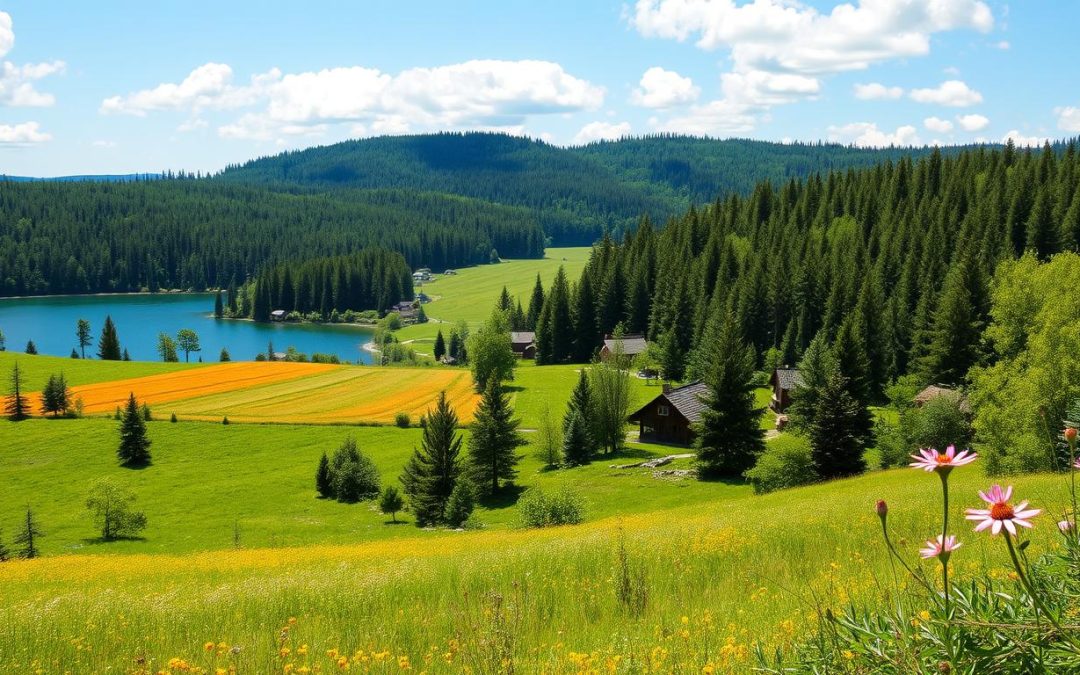Ever thought about how a small Baltic nation keeps its languages diverse while keeping its culture alive? Estonia shows us a unique mix of languages that breaks down old language barriers.
The Estonian language is the official tongue of this country. It’s part of the Finnic branch of Uralic languages. With about 1.1 million speakers worldwide, Estonian is more than just a way to talk—it’s a symbol of Estonia’s strength and heritage.
Estonia’s language scene is quite varied. Estonian is mixed with many minority languages. Russian is the top minority language, with 56% of foreign language speakers. English, Finnish, and German also play big roles in everyday talk.
Key Takeaways
- Estonian is the official language with deep Finnic roots
- Approximately 1.1 million people speak Estonian worldwide
- Russian is the most significant minority language
- 50% of Estonians speak English as a foreign language
- The language reflects a complex historical and cultural evolution
Overview of Estonian Linguistic Landscape
Estonia’s language scene is both rich and complex. It shows the country’s deep cultural roots and its history. The mix of languages here tells a story of strength, change, and diversity.
The language scene in Estonia is full of variety and interesting dynamics. Exploring this landscape gives us valuable insights:
- Estonian is the official language, spoken by about 1.1 million people
- About 50% of the population also speaks English
- Many languages live together in both cities and countryside
Current Language Demographics
The way languages are spread in Estonia is quite complex. In cities like Tallinn, we see a detailed picture of language use:
| District | Monolingual Signs | Bilingual Signs | Multilingual Signs |
|---|---|---|---|
| Nõmme | 62% | 28% | 10% |
| Lasnamäe | 45% | 35% | 20% |
| Kesklinn | 55% | 30% | 15% |
Historical Language Development
The history of languages in Estonia is full of change. It goes from ancient times to periods under foreign rule. The languages have mixed, influenced by German, Russian, and Nordic cultures.
Language Policy Framework
Estonia’s language policy tries to keep its national language strong while also valuing diversity. The government works to protect Estonian and help minority languages. This makes Estonia a welcoming place for many languages and cultures.
“Language is the roadmap of a culture. It tells you where its people come from and where they are going.” – Rita Mae Brown
Estonian: The National Language
Estonia’s language is at the heart of its national identity. It’s a treasure that connects people across generations. It keeps the culture alive.

Origins and Evolutionary Journey
The Estonian language comes from the Finnic branch of the Uralic family. It developed alone, keeping its own special traits. This makes it different from other European languages.
- Part of the Uralic language family
- Closely related to Finnish
- Distantly connected to Hungarian
Unique Linguistic Features
Estonian is known for its complex language. It has 14 noun cases and a special vowel system. These features create unique sounds.
“Estonian is not just a language, it’s a living narrative of a nation’s soul.” – Language Preservation Expert
Role in Modern Society
About 1.1 million people speak Estonian natively. It’s key for communication in Estonia. Around 84% of the population speaks it, with 67% as their first language and 17% as a second.
| Language Statistic | Percentage |
|---|---|
| Native Estonian Speakers | 67% |
| Estonian as Second Language | 17% |
| Foreign Language Speakers | 76% |
The Estonian language is adapting to new tech while keeping its identity. Its ability to change shows Estonia’s dedication to culture and language.
Russian Language in Estonia
The Russian language is very important in Estonia. About 29% of people say Russian is their first language. This makes it the biggest minority language in the country.
This importance comes from Estonia’s history. Many people moved there during the Soviet era. This changed who lived in Estonia.
Most Russian speakers live in the northeast. Cities like Narva have a lot of Russian speakers. This mix of languages makes Estonia’s culture very interesting.
- Russian is spoken by nearly one-third of Estonia’s population
- Northeastern regions have highest concentration of Russian speakers
- Historical Soviet-era migration significantly influenced language demographics
Estonia tries to include Russian speakers in its society. It has rules to help everyone speak Estonian. Schools and programs help everyone understand each other better.
“Language is the road map of a culture. It tells you where its people come from and where they are going.” – Rita Mae Brown
To understand Estonia, we must see how history, culture, and today’s efforts mix together. This shows how important the Russian language is in Estonia.
Other Widely Spoken Languages in Estonia
Estonia is more than just Estonian and Russian. It’s a place where many languages come together. These minority languages add to the country’s rich culture. They tell stories of Estonia’s history and people.

Regional Language Distribution
In Estonia, languages vary by region. Each area has its own language story. This shows the country’s deep linguistic diversity.
- Võro and Seto languages are spoken by around 100,000 individuals in southeastern Estonia
- Russian remains the most prominent minority language, spoken by approximately 56% of foreign language speakers
- English is widely understood by about 50% of the population
- Finnish is spoken by approximately 21% of Estonians
- German is understood by around 15% of the population
Official Status and Recognition
Estonia values its minority languages. Estonian is the official language, but others get support too. This shows Estonia’s commitment to language diversity.
| Language | Speakers | Official Status |
|---|---|---|
| Võro | Approximately 50,000 | Recognized regional language |
| Seto | Around 50,000 | Recognized regional language |
| Swedish | Very few remaining speakers | Historical minority language |
| Ukrainian | Limited speakers | Immigrant community language |
Social Integration Impact
Many languages in Estonia help people connect. They build bridges between cultures. This leads to understanding and respect among all.
“Language is the roadmap of a culture. It tells you where its people come from and where they are going.” – Rita Mae Brown
Learning about Estonia’s languages shows its dedication to culture and unity. It’s a place where everyone’s voice is heard.
Regional and Minority Languages
Estonia has a rich mix of languages beyond its official one. Explore the regional and minority languages that enrich the country’s culture.
The minority languages of Estonia are a mix of old and new. Võro and Seto are unique regional languages from the south. They were once seen as dialects but are now recognized as their own languages.
- Võro language: Spoken by approximately 74,499 people
- Seto dialect: Used by around 12,549 individuals
- Mulgi language: Recorded 9,698 speakers in the 2011 census
- Tartu language: 4,109 speakers identified in the same census
Keeping these minority languages alive shows Estonia’s dedication to its linguistic heritage. Local groups work hard to keep their language traditions alive. They do this through cultural events, education, and community projects.
Language is the roadmap of a culture. It tells you where its people come from and where they are going.
Estonia also values other languages, like Russian, especially in towns like Narva. The country’s multilingual environment helps these languages survive in today’s world.
Estonia does more than just save these languages. It supports these communities, seeing their value in keeping culture and history alive.
Interesting fact: Over 50% of first- and second-generation immigrants in Estonia have adopted the Estonian language, showcasing the country’s inclusive linguistic landscape.
Estonian Sign Language and Communication Access
Estonia shows a strong commitment to making language accessible to everyone. It values visual communication for those who are deaf or hard of hearing. This makes the country’s society more inclusive.
Development and Historical Context
Estonian Sign Language (EVK) has a long history. It started in 1866 at the first Deaf school in Vändra, Pärnu County. Over time, it has grown and was officially recognized in 2007.
- Approximately 2,000 deaf people use EVK as their first language
- Connections to French Sign Language family
- Official status achieved in 2007
Educational Support and Community Integration
In Estonia, deaf citizens get full support from the government. They offer interpreter services and educational programs. These help deaf people fully join in with society.
| Language Support Aspect | Details |
|---|---|
| Sign Language Users | Approximately 2,000 primary EVK users |
| Legal Recognition | Official language status since 2007 |
| Community Organization | Eesti Viipekeele Selts founded in 2020 |
“Communication is not just about speaking, but understanding and being understood.” – Estonian Sign Language advocate
Estonia sees sign language as a key part of its language scene. This ensures deaf people have the same chances as everyone else to communicate and be part of the community.
Foreign Language Education System
Estonia is known for its multilingual society and strong foreign language education. The country’s language learning strategy is both smart and all-encompassing. It helps students develop strong language skills from a young age.
The Estonian model focuses on learning multiple foreign languages. Students must study at least two foreign languages, besides their native tongue. This creates a diverse linguistic environment.
“Language is the road map of a culture. It tells you where its people come from and where they are going.” – Rita Mae Brown
Key aspects of Estonia’s foreign language education include:
- English is taught in nearly 100% of schools, with 77% of students participating in English language classes
- Russian remains an important second language, though its usage is gradually decreasing
- German emerges as the third most popular foreign language
- 15% of higher education programs are offered in English, attracting both local and international students
The education system uses digital platforms and e-learning tools to improve language skills. This shows Estonia’s digital focus and readiness for a global world.
About 40% of adults in Estonia take part in non-formal language learning. This shows a strong cultural support for language diversity and ongoing education.
By focusing on language skills, Estonia prepares its citizens to communicate across different cultures. At the same time, they keep a strong connection to their native Estonian language.
Historical Germanic Influence on Estonian Language
The Estonian language has a deep connection to Germanic languages. This connection started a long time ago. It has shaped Estonia’s language and culture.

In the 13th century, the Teutonic Knights came to Estonia. They brought German language and culture. Today, about 25 percent of Estonian words come from Low German.
Baltic German Cultural Legacy
Baltic Germans were important for Estonia’s language. They helped shape the Estonian language in many ways. This includes:
- Administrative terminology
- Educational vocabulary
- Cultural and social lexicon
Modern German Language Usage
German still has a place in Estonia today. It’s not a minority language, but it’s still important. It keeps Estonia connected to its past.
| Period | Germanic Language Impact |
|---|---|
| Medieval Era | Extensive administrative and educational influence |
| Modern Era | Cultural exchange and limited language usage |
| Contemporary Period | Academic and business communication |
The Estonian language shows the influence of Germanic languages. This history is part of Estonia’s rich culture. It shows how languages can connect people over time.
*Language is the road map of a culture. It tells you where its people come from and where they are going.* – Rita Mae Brown
Language Preservation and Cultural Identity
The Estonian language is a strong symbol of national strength and cultural identity. During tough times, like the Soviet era, it was a key way for Estonians to resist and keep their culture alive.
“Language is the roadmap of a culture. It tells you where its people come from and where they are going.” – Rita Mae Brown
Estonia has taken steps to protect and boost its unique language. The Estonian Language Strategy 2021-2035 shows a detailed plan to keep the language alive. It focuses on several important areas:
- Developing advanced speech recognition technologies
- Supporting digital language resources
- Protecting linguistic diversity
- Promoting Estonian language learning
The effort to save the language is clear in Estonia’s tech and cultural wins:
| Language Preservation Metric | Current Status |
|---|---|
| Speech Recognition Accuracy | 85% (Target: 91%) |
| Total Estonian Speakers | 1.1 million worldwide |
| Language Technology Support | Top 100 global languages |
Learning about Estonia’s language shows a deep commitment to its culture. The Estonian language is growing, mixing old traditions with new tech.
Digital Language Environment
Estonia leads in digital innovation, creating a multilingual digital world. This world connects people across its diverse society. The country’s focus on technology has changed how languages meet online.

Your experience online in Estonia shows a smart way to use technology for all. The nation has built amazing digital tools to support its many languages.
E-Services Across Languages
Estonia’s digital world offers e-services in many languages, making sure everyone is included. Key features include:
- Real-time AI-generated subtitles for TV shows
- Voice-activated public service platform Bürokratt
- Speech recognition for government services
- Electronic ID card for different language interactions
Digital Language Preservation Initiatives
Projects are working to keep and grow languages online. The “Donate Your Speech” campaign is building a big database of spoken Estonian. This helps document languages and advance technology.
“Technology is not just a tool, but a bridge connecting linguistic communities” – Estonian Digital Language Strategy
Estonia shows how tech can make language use smooth and inclusive. With 99% of financial deals online and over 339 million digital signatures, Estonia leads the way.
Language Demographics and Future Trends
Estonia’s language scene is changing fast, showing a vibrant multilingual society. The country’s language numbers are shifting, thanks to new generations and global trends.
Recent census data shows big changes in language use and population:
- Estonian is still the main language, with 69.4% of people identifying as ethnic Estonians
- Russians make up 22% of the population, with numbers going down
- English is becoming more popular among the young
“Language is the roadmap of a culture. It tells you where its people come from and where they are going.” – Rita Mae Brown
The language trends in Estonia are quite interesting:
| Language Group | 2011 Percentage | 2021 Percentage | Trend |
|---|---|---|---|
| Estonian Speakers | 68.5% | 67.6% | Slight Decline |
| Russian Speakers | 29.6% | 27.2% | Decreasing |
| English Speakers | 10% | 15% | Rising |
By 2024, Estonia will keep embracing its multilingual identity. Young people see English as key for communication, while keeping Estonian alive. The future looks diverse, with many languages living together.
There might be challenges ahead, like keeping Estonian’s cultural value in a global world. Estonia is finding a balance between new tech and keeping its language alive.
Conclusion
Estonia’s language scene is full of life and diversity. The Estonian language is key to the nation’s identity. It’s not just a way to talk but also a deep cultural symbol.
With 68% of the population being ethnic Estonians, the country values its language a lot. It shows how Estonia keeps its language alive while also connecting with the world.
Estonia’s approach to languages is smart and open. It supports minority languages and has strong programs for learning foreign tongues. This makes Estonia a welcoming place for many languages.
The digital world has made learning languages easier in Estonia. New tools and platforms help people from different backgrounds to communicate better.
Estonia is dedicated to teaching languages in new ways. Since 2011, it has made policies that support speaking many languages. This shows Estonia’s forward-thinking approach to language.
Exploring Estonia’s language shows us that language is more than words. It shows who we are, how we interact, and how we grow as a nation. Estonia balances old traditions with new ideas, creating a rich language scene.
The above is subject to change.
Check back often to TRAVEL.COM for the latest travel tips and deals.
Here are some Tours & Sightseeing suggestions that might pique your interests!
